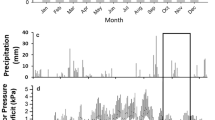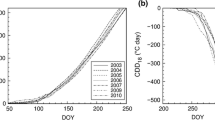Abstract
Aims
Two contrasting canopy manipulations were compared to unpruned controls on London plane trees, to determine the effects on canopy regrowth, soil and leaf water relations.
Methods
‘Canopy reduction’, was achieved by removing the outer 30 % length of all major branches and ‘canopy thinning’, by removing 30 % of lateral branches arising from major branches.
Results
Total canopy leaf areas recovered within two and three years of pruning for the canopy-thinned and reduced trees respectively. Canopy reduction increased mean leaf size, nitrogen concentration, canopy leaf area density and conserved soil moisture for up to 3 years, whereas canopy thinning had no effects. Another experiment compared more severe canopy reduction to unpruned trees. This produced a similar growth response to the previous experiment, but soil moisture was conserved nearer to the trunk. Analysis of 13C and 18O signals along with leaf water relations and soil moisture data suggested that lower boundary layer conductance within the canopy-reduced trees restricted tree water use, whereas for the canopy-thinned trees the opposite occurred.
Conclusions
Only canopy reduction conserved soil moisture and this was due to a combination of reduced total canopy leaf area and structural changes in canopy architecture.



Similar content being viewed by others
References
Atkinson D (1980) The distribution and effectiveness of the roots of tree crops. Hortic Rev 2:424–490
Berry G (1964) The evaluation of Penman’s natural evaporation formula by electric computer. Aust J Appl Sci 15:61–64
Biddle PG (1983) Patterns of soil drying and moisture deficit in the vicinity of trees on clay soils. Geotechnique 33:107–126
BS 3998:2010 (2010) Tree work recommendation. British Standards Institute, London
Cepuder P, Evett S, Heng LK, Hignett C, Laurent JP, Ruelle P (2008) Field estimation of soil water content, a practical guide to methods, instrumentation and sensor technology, Training course series No 30. International Atomic Energy Agency, Vienna, p 131pp
Cerasoli S, Scartazza A, Brugnoli E, Chaves MM, Pereira JS (2004) Effects of partial defoliation and carbon and nitrogen partitioning and photosynthetic carbon uptake by two-year-old cork oak (Quercus suber) saplings. Tree Physiol 24:83–90
Cernusak LA, Kahman A (2013) The multifaceted relationship between leaf water 18O enrichment and transpiration rate. Plant Cell Environ 36:1239–1241
Comas LH, Eissenstat DM (2004) Linking fine root traits to maximum potential growth rate among 11 mature temperate tree species. Funct Ecol 18:388–397
Loss Prevention Council (1995) Subsidence and domestic housing survey: analysis of results, LRP4:1995. Loss Prevention Council, Boreham Wood
Crilly M (2001) Analysis of a data base of subsidence damage. Struct Surv 19:7–14
Cutler DF, Richardson IBK (1997) Tree roots and buildings, 2nd edn. Addison Wesley Longman Ltd, Harlow
Dawson TE (1996) Determining water use by trees and forests from isotopic, energy balance and transpiration analyses: the roles of tree size and hydraulic lift. Tree Physiol 16:263–272
Day SD, Wiseman PE, Dickinson SB, Harris RJ (2010) Contemporary concepts of root system architecture of urban trees. Arboricult Urban For 36:149–159
Delta–T Devices (1999) HemiView User Manual Version 2.1 Delta-T Devices Ltd, Cambridge UK
Development Core Team R (2008) R: A language and environment for statistical computing. R Foundation for Statistical Computing, Vienna
Doornkamp C (1993) Clay shrinkage induced subsidence. Geophys J Roy Astron Soc 159:196–202
Driscoll R (1983) The influence of vegetation on the swelling and shrinking of clay soils in Britain. Geophys J Roy Astron Soc 33:93–105
Dunn JM (2005) The effects of two contracting canopy manipulations on the growth and water use of Prunus avium. PhD thesis University of Cambridge
Eissenstat DM, Duncan LW (1992) Root growth and carbohydrate responses in bearing citrus trees following partial canopy removal. Tree Physiol 10:245–257
Epstein S, Mayeda T (1953) Variation of 18O content of waters from natural sources. Geochim Cosmochim Acta 4:213–224
Farquhar GD, Cernusak LA (2005) On the isotopic composition of leaf water in the non-steady state. Funct Plant Biol 32:293–303
Farquhar GD, Ehleringer JR, Hubick KT (1989) Carbon isotope discrimination and photosynthesis. Annu Rev Plant Physiol Plant Mol Biol 40:503–537
Fordham SJ, Green RD (1980) Soils of kent, soil survey bulletin No. 9. The Soil Survey, Rothamsted Experimental Station, Harpenden
Gill SE, Handley JF, Ennos AR, Pauleit S (2007) Adapting cities for climate change: the role of the green infrastructure. Built Environ 33:115–133
Grant DR (1975) Measurement of soil moisture near the surface using a neutron moisture meter. J Soil Sci 26:124–129
Head GC (1969) The effects of fruiting and defoliation on seasonal trends in new root production on apple trees. J Hortic Sci 44:175–181
Jackson NA, Wallace JS, Ong CK (2000) Tree pruning as a means of controlling water use in an agroforestry system in Kenya. For Ecol Manag 126:133–148
Jarvis PG, McNaughton KG (1986) Stomatal control of transpiration—scaling up from leaf to region. Adv Ecol Res 15:1–49
Kjelgren R, Clark J (1992) Microclimates and tree growth in three urban spaces. J Environ Hortic 10:139–145
Kjelgren R, Montague T (1998) Urban tree transpiration over turf and asphalt surfaces. Atmos Environ 32:35–41
Kozlowski TT (1971a) Growth and development of trees, volume I seed germination, ontogeny, and shoot growth. Academic, London
Kozlowski TT (1971b) Growth and development of trees, volume II cambial growth, root growth, and reproductive growth. Academic, London
London Tree Officers Association (1995) A risk limitation strategy for tree root claims. London Tree Officers Association, Hosted by Islington Council, London
Mediene S, Jordan MO, Pages L, Lebot J, Adamowicz S (2002) The influence of severe shoot pruning on growth, carbon and nitrogen status in young peach trees (Prunus persica). Tree Physiol 22:1289–1296
Misson L, Gershenson A, Tang J, McKay M, Cheng W, Goldstein A (2006) Influences of canopy photosynthesis and summer rain pulses on root dynamics and soil respiration in a young ponderosa pine forest. Tree Physiol 26:833–844
Morris DA (1996) Hormonal regulation of sink-source relationships: an overview of potential mechanisms. In: Zamski E, Schaffer AA (eds) Photoassimilate distribution in plants and crops. Marcel Dekker, New York, pp 441–465
Sanders C, Phillipson MC (2003) UK adaptation strategy and technical measures: the impacts of climate change on buildings. Build Res Inf 31:210–221
Seibt U, Rajabi A, Griffiths H, Berry J (2008) Carbon isotopes and water use efficiency—sense and sensitivity. Oecologia 155:441–454
Tschaplinski TJ, Blake TJ (1995) Growth and carbohydrate status of coppice shoots of hybrid poplar following shoot pruning. Tree Physiol 15:333–338
Tyree MT, Ewers FW (1991) The hydraulic architecture of trees and other woody plants. New Phytol 119:345–360
VSN International (2011) GenStat for Windows, 14th edn. VSN International Hemel Hempstead, UK
Wang XF, Yakir D (1995) Temporal and spatial variances in oxygen-18 content of leaf water in different plant species. Plant Cell Environ 18:1377–1385
Weiner J (2004) Allocation, plasticity and allometry in plants. Build Res Inf Evol Syst 6:207–215
Whitehead D (1998) Regulation of stomatal conductance and transpiration in forest canopies. Tree Physiol 18:633–644
Wood J (1999) Leaf area of a single tree. Hemi view application note. Delta-T Devices Ltd, Cambridge UK
Wullschleger SD, Meinzer FC, Vertessy RA (1998) A review of whole plant water use studies in trees. Tree Physiol 18:499–512
Wullschleger SD, Wilson KB, Hanson PJ (2000) Environmental control of whole plant transpiration, canopy conductance and estimates of the decoupling coefficient for large red maple trees. Agric For Met 104:157–168
Zuur A, Leno EN, Walker N, Saveliev AA, Smith GM (2009) Mixed effects models and extensions in ecology with R. Springer, New York
Acknowledgments
This work was funded via the Department of Environment, and Food and Agriculture, Horticulture LINK 212 with contributions from Department of Communities and Government, the Highways Agency, the Association of British Insurers, the East Malling Trust and Delta-T Devices Ltd. We thank the Building Research Establishment, Delta-T Devices Ltd, the Arboricultural Association, and Drs Giles Biddle and Mike Fordham for their technical support and contributions. We thank Dr Stephen Young for his extensive advice and the statistical analyses of the soil moisture deficit data.
Author information
Authors and Affiliations
Corresponding author
Additional information
Responsible Editor: Tibor Kalapos.
Rights and permissions
About this article
Cite this article
Hipps, N.A., Davies, M.J., Dunn, J.M. et al. Effects of two contrasting canopy manipulations on growth and water use of London plane (Platanus x acerifolia) trees. Plant Soil 382, 61–74 (2014). https://doi.org/10.1007/s11104-014-2143-4
Received:
Accepted:
Published:
Issue Date:
DOI: https://doi.org/10.1007/s11104-014-2143-4




